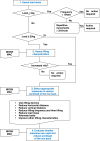An Evidence-Based Multidisciplinary Practice Guideline to Reduce the Workload due to Lifting for Preventing Work-Related Low Back Pain
- PMID: 24999432
- PMCID: PMC4081511
- DOI: 10.1186/2052-4374-26-16
An Evidence-Based Multidisciplinary Practice Guideline to Reduce the Workload due to Lifting for Preventing Work-Related Low Back Pain
Abstract
We developed an evidence-based practice guideline to support occupational safety and health (OSH) professionals in assessing the risk due to lifting and in selecting effective preventive measures for low back pain (LBP) in the Netherlands. The guideline was developed at the request of the Dutch government by a project team of experts and OSH professionals in lifting and work-related LBP. The recommendations for risk assessment were based on the quality of instruments to assess the risk on LBP due to lifting. Recommendations for interventions were based on a systematic review of the effects of worker- and work directed interventions to reduce back load due to lifting. The quality of the evidence was rated as strong (A), moderate (B), limited (C) or based on consensus (D). Finally, eight experts and twenty-four OSH professionals commented on and evaluated the content and the feasibility of the preliminary guideline. For risk assessment we recommend loads heavier than 25 kg always to be considered a risk for LBP while loads less than 3 kg do not pose a risk. For loads between 3-25 kg, risk assessment shall be performed using the Manual handling Assessment Charts (MAC)-Tool or National Institute for Occupational Safety and Health (NIOSH) lifting equation. Effective work oriented interventions are patient lifting devices (Level A) and lifting devices for goods (Level C), optimizing working height (Level A) and reducing load mass (Level C). Ineffective work oriented preventive measures are regulations to ban lifting without proper alternatives (Level D). We do not recommend worker-oriented interventions but consider personal lift assist devices as promising (Level C). Ineffective worker-oriented preventive measures are training in lifting technique (Level A), use of back-belts (Level A) and pre-employment medical examinations (Level A). This multidisciplinary evidence-based practice guideline gives clear criteria whether an employee is at risk for LBP while lifting and provides an easy-reference for (in)effective risk reduction measures based on scientific evidence, experience, and consensus among OSH experts and practitioners.
Keywords: Back pain; Interventions; Lifting; Occupational health care; Practice guideline; Prevention; Surveillance.
Figures
References
-
- European Foundation for the Improvement of Living and Working Conditions. Work and Health: a Difficult Relationship? Eurofound; 2011. http://www.eurofound.europa.eu/pubdocs/2011/17/en/1/EF1117EN.pdf.
-
- Hooftman W, Klein Hesselink J, Van Genabeek J, Wiezer N, Willems D. Dutch: Arbobalans 2010: Kwaliteit van de Arbeid, Effecten en Maatregelen in Nederland. Hoofddorp (The Netherlands): TNO Innovation for Life; 2011. Working Conditions Overview 2010: Quality of Labour, Consequences and Measures Taken in the Netherlands. 978-90-5986-381-1.
-
- Lötters F, Burdorf A, Kuiper J, Miedema H. Model for the work-relatedness of low-back pain. Scand J Work Environ Health. 2003;29(6):431–440. - PubMed
-
- Bakker EW, Verhagen AP, van Trijffel E, Lucas C, Koes BW. Spinal mechanical load as a risk factor for low back pain: a systematic review of prospective cohort studies. Spine. 2009;34:E281–E293. - PubMed
-
- Wai EK, Roffey DM, Bishop P, Kwon BK, Dagenais S. Causal assessment of occupational lifting and low back pain: results of a systematic review. Spine J. 2010;10:554–566. - PubMed
Publication types
LinkOut - more resources
Full Text Sources
Other Literature Sources
Miscellaneous


